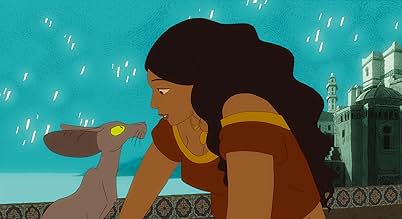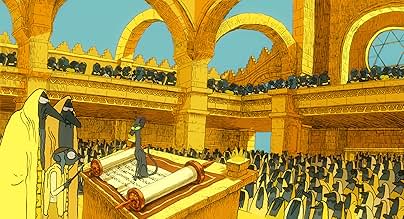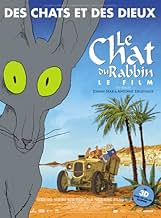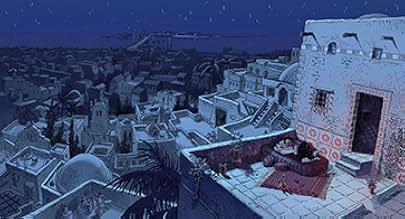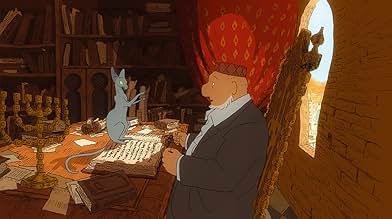AVALIAÇÃO DA IMDb
7,1/10
3,8 mil
SUA AVALIAÇÃO
Adicionar um enredo no seu idiomaSet in Algeria in the 1920s, a rabbi's cat who learns how to speak after swallowing the family parrot expresses his desire to convert to Judaism.Set in Algeria in the 1920s, a rabbi's cat who learns how to speak after swallowing the family parrot expresses his desire to convert to Judaism.Set in Algeria in the 1920s, a rabbi's cat who learns how to speak after swallowing the family parrot expresses his desire to convert to Judaism.
- Prêmios
- 3 vitórias e 4 indicações no total
François Morel
- Le Chat
- (narração)
Hafsia Herzi
- Zlabya
- (narração)
Maurice Bénichou
- Le Rabbin Sfar
- (narração)
- …
Jean-Pierre Kalfon
- Le Malka des Lions
- (narração)
François Damiens
- Le Reporter
- (narração)
Mohamed Fellag
- Le Cheikh Sfar
- (narração)
- (as Fellag)
Daniel Cohen
- Le Rabbin du Rabbin
- (narração)
Eric Elmosnino
- Le Professeur Soliman
- (narração)
Mathieu Amalric
- Le Prince
- (narração)
Wojciech Pszoniak
- Vastenov
- (narração)
- (as Wojtek Pszoniak)
Sava Lolov
- Le Peintre Russe
- (narração)
Alice Houri
- Knidelette
- (narração)
Marguerite Abouet
- L'Africaine
- (narração)
Karina Testa
- Une Copine de Zlabya
- (narração)
Siham Gharnit
- Une Copine de Zlabya
- (narração)
Jean-Claude Frissung
- Le Curé
- (narração)
Jacky Ido
- Le Chef de la Tribu
- (narração)
- (as John Pucc')
Pascal N'Zonzi
- Premier Géant
- (narração)
Enredo
Você sabia?
- CuriosidadesFrench visa #119442 delivered on 9-5-2011.
- Erros de gravaçãoWhen they are prepping Vastenov's Citroën for the road trip, the Russian winds up painting a combined symbol representing both Russia and Jerusalem. However, you can see this symbol already painted on the Citroën when the titular Rabbi is first checking out the vehicle in Vastenov's garage.
- ConexõesFeatures As Aventuras de Tintim (1991)
Avaliação em destaque
Winner of this year's Cesar Awards for Best Animated Film, The Rabbi's Cat directed by Joann Sfar and Antoine Delesvaux is based on a comic series by Sfar, which made the narrative seem a little bit too choppy as it sprawls from a focused introduction, to something of a wandering road trip for the second half of the film that didn't seem to have a point other than to drag it out beyond its welcome. Sure it had enough comedy and quirkiness thanks to the titular cat, but alas repetition doesn't serve it well when issues and comical moments get recycled.
The animation of course is gorgeous to look at given that it's something different from the usual Hollywood studio products, and hand drawn rather than something polished off a computer, or dabbling with the 3D gimmick (though I read elsewhere that there was a 3D version overseas, which is strange given the lack of usual 3D styled visuals). The cat itself requires a little getting used to for the way it's designed and drawn, looking quite unlike any cat you've seen, with its elongated facial features and an extremely long tail.
We follow the adventures of the titular cat, who got his speaking voice (by Francois Morel) thanks to an envy and fatal attack which we don't really get to see, against the parrot of his mistress Zlabya (Hafsia Herzi), the voluptuous daughter of the rabbi Sfar (Maurice Benichou), an easy going religious man. He speaks, to the surprise of his owners, and soon declares that he wants to be a Jew, and to complete the bar mitzvah, in order to get Sfar's approval to remain by Zlabya's side (he has the hots for her you see), instead of being chased away as a monstrosity with his new found voice, akin to being the work of the devil.
Much of the narrative for the first half of the film could be seen as an open discussion between religions such as Judaism, Islam and Christianity, set in 1920s Algeria where there's a clash of cultures with the French, as well as the highlighted differences between the various religions, factions and groups that co-existed at the time. One would need to be sensitive of Algeria in that era in order to milk the most of out this picture, given the lack of background focus as it jumps directly into discussions assuming one would be knowledgeable of the issues of the time.
But even if you're not, then the second half's road trip is probably where you can still follow, where a whole host of characters got introduced, such as an Arabic Sheik of the desert (Mathieu Amalric) with whom the rabbi, his cat and their entourage got into a tangle with, a Russian painter and an African girl that they pick up, and a surprisingly little episode involving a famous Belgian reporter and his dog. It's all downhill from there in their quest to find utopia, as the narrative meanders in too episodic a fashion without an end in sight, leaving things quite open ended in its finale perhaps promising of more adventures to come, but is probably a cliffhanger just like chapters in the comic books.
The animation of course is gorgeous to look at given that it's something different from the usual Hollywood studio products, and hand drawn rather than something polished off a computer, or dabbling with the 3D gimmick (though I read elsewhere that there was a 3D version overseas, which is strange given the lack of usual 3D styled visuals). The cat itself requires a little getting used to for the way it's designed and drawn, looking quite unlike any cat you've seen, with its elongated facial features and an extremely long tail.
We follow the adventures of the titular cat, who got his speaking voice (by Francois Morel) thanks to an envy and fatal attack which we don't really get to see, against the parrot of his mistress Zlabya (Hafsia Herzi), the voluptuous daughter of the rabbi Sfar (Maurice Benichou), an easy going religious man. He speaks, to the surprise of his owners, and soon declares that he wants to be a Jew, and to complete the bar mitzvah, in order to get Sfar's approval to remain by Zlabya's side (he has the hots for her you see), instead of being chased away as a monstrosity with his new found voice, akin to being the work of the devil.
Much of the narrative for the first half of the film could be seen as an open discussion between religions such as Judaism, Islam and Christianity, set in 1920s Algeria where there's a clash of cultures with the French, as well as the highlighted differences between the various religions, factions and groups that co-existed at the time. One would need to be sensitive of Algeria in that era in order to milk the most of out this picture, given the lack of background focus as it jumps directly into discussions assuming one would be knowledgeable of the issues of the time.
But even if you're not, then the second half's road trip is probably where you can still follow, where a whole host of characters got introduced, such as an Arabic Sheik of the desert (Mathieu Amalric) with whom the rabbi, his cat and their entourage got into a tangle with, a Russian painter and an African girl that they pick up, and a surprisingly little episode involving a famous Belgian reporter and his dog. It's all downhill from there in their quest to find utopia, as the narrative meanders in too episodic a fashion without an end in sight, leaving things quite open ended in its finale perhaps promising of more adventures to come, but is probably a cliffhanger just like chapters in the comic books.
- DICK STEEL
- 9 de abr. de 2012
- Link permanente
Principais escolhas
Faça login para avaliar e ver a lista de recomendações personalizadas
- How long is The Rabbi's Cat?Fornecido pela Alexa
Detalhes
- Data de lançamento
- País de origem
- Centrais de atendimento oficiais
- Idiomas
- Também conhecido como
- The Rabbi's Cat
- Empresas de produção
- Consulte mais créditos da empresa na IMDbPro
Bilheteria
- Orçamento
- € 12.500.000 (estimativa)
- Faturamento bruto nos EUA e Canadá
- US$ 23.392
- Fim de semana de estreia nos EUA e Canadá
- US$ 4.301
- 9 de dez. de 2012
- Faturamento bruto mundial
- US$ 4.208.573
- Tempo de duração1 hora 40 minutos
- Cor
- Mixagem de som
- Proporção
- 1.85 : 1
Contribua para esta página
Sugerir uma alteração ou adicionar conteúdo ausente



